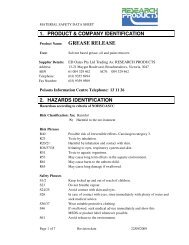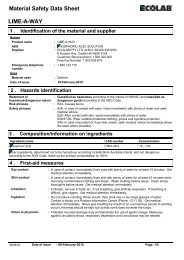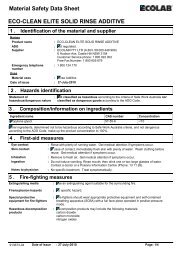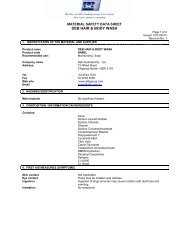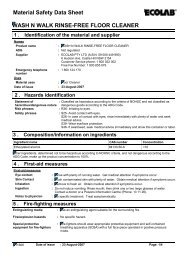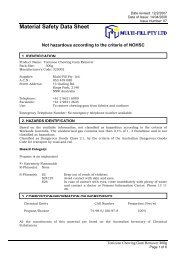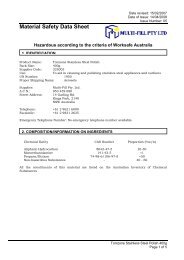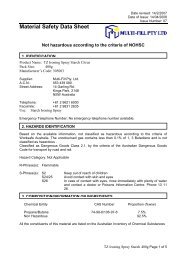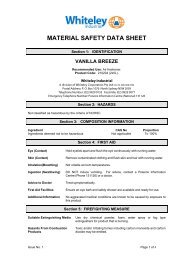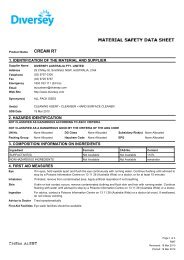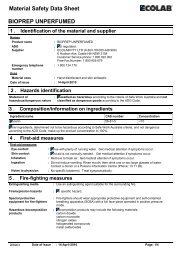Diversey - Clean Air - msds - Perth Cleaning Supplies
Diversey - Clean Air - msds - Perth Cleaning Supplies
Diversey - Clean Air - msds - Perth Cleaning Supplies
You also want an ePaper? Increase the reach of your titles
YUMPU automatically turns print PDFs into web optimized ePapers that Google loves.
Product NameCLEAN AIR1. IDENTIFICATION OF THE MATERIAL AND SUPPLIERSupplier NameAddressTelephoneFaxEmergencyEmailWeb SiteSynonym(s)DIVERSEY AUSTRALIA PTY. LIMITED29 Chifley St, Smithfield, NSW, AUSTRALIA, 2164(02) 9757 0300(02) 9725 57671800 033 111 (24 hrs)aucustserv@diversey.comhttp://www.diversey.comALL PACK SIZESUse(s)SDS DateAIR FRESHENER • COMMERCIAL GRADE DISINFECTANT19 Mar 20102. HAZARDS IDENTIFICATIONNOT CLASSIFIED AS HAZARDOUS ACCORDING TO ASCC CRITERIANOT CLASSIFIED AS A DANGEROUS GOOD BY THE CRITERIA OF THE ADG CODEUN No.Packing GroupNone Allocated DG Class None Allocated Subsidiary Risk(s) None AllocatedNone Allocated Hazchem Code None Allocated EPGNone Allocated3. COMPOSITION/ INFORMATION ON INGREDIENTSIngredient Formula CAS No. ContentNON HAZARDOUS INGREDIENTS Not Available Not Available >60%QUATERNARY AMMONIUM COMPOUND Not Available Not Available
Product NameCLEAN AIR5. FIRE FIGHTING MEASURESFlammabilityFire andExplosionExtinguishingHazchem CodeNon flammable. May evolve toxic gases (carbon/ nitrogen oxides, ammonia, chlorides, hydrocarbons) whenheated to decomposition.Evacuate area and contact emergency services. Toxic gases may be evolved in a fire situation. Remain upwindand notify those downwind of hazard. Wear full protective equipment including Self Contained BreathingApparatus (SCBA) when combating fire. Use waterfog to cool intact containers and nearby storage areas.Prevent contamination of drains or waterways.None Allocated6. ACCIDENTAL RELEASE MEASURESSpillageIf spilt (bulk), use personal protective equipment. Contain spillage, then cover / absorb spill with non-combustibleabsorbant material (vermiculite, sand, or similar), collect and place in suitable containers for disposal. <strong>Clean</strong> spillsite with water. For small spills, dilute with water and flush to sewer. CAUTION: Spill site may be slippery.7. STORAGE AND HANDLINGStorageHandlingStore in a cool, dry, well ventilated area, removed from oxidising agents, anionic detergents, heat or ignitionsources and foodstuffs. Ensure containers are adequately labelled, protected from physical damage and sealedwhen not in use. Check regularly for leaks or spills.Before use carefully read the product label. Use of safe work practices are recommended to avoid eye or skincontact and inhalation. Observe good personal hygiene, including washing hands before eating. Prohibit eating,drinking and smoking in contaminated areas.8. EXPOSURE CONTROLS/ PERSONAL PROTECTIONExposure StdsNo exposure standard(s) allocated.Biological LimitsEngineeringControlsPPENo biological limit allocated.Avoid inhalation. Use in well ventilated areas.Personal Protective Equipment is not required under normal conditions of use.Protection of hands: Rinseand dry hands after use. For prolonged contact protection for the skin may be necessary.Eye protection: Safety glasses are not normally required. However, their use is recommended in those caseswhere handling the undiluted product involves a risk of splashing. With prolonged use, wear: rubber or PVCgloves and safety glasses.9. PHYSICAL AND CHEMICAL PROPERTIESAppearance CLEAR RED LIQUID Solubility (Water) SOLUBLEOdour FLORAL ODOUR Specific Gravity 0.999 (Approximately)pH 6.0 - 7.5 % Volatiles > 60 % (Water)Vapour Pressure 18 mm Hg @ 20°C Flammability NON FLAMMABLEVapour Density NOT AVAILABLE Flash Point NOT RELEVANTBoiling Point 100°C (Approximately) Upper Explosion Limit NOT AVAILABLEMelting Point < 0°C Lower Explosion Limit NOT AVAILABLEEvaporation RateAS FOR WATERPage 2 of 4RMTReviewed: 19 Mar 2010Printed: 19 Mar 2010
Product NameCLEAN AIR10. STABILITY AND REACTIVITYChemical StabilityConditions to AvoidMaterial to AvoidDecompositionHazardous ReactionsHealth HazardSummaryEyeInhalationSkinIngestionToxicity DataStable under recommended conditions of storage.Avoid heat, sparks, open flames and other ignition sources.Incompatible with oxidising agents (eg. hypochlorites), anionic detergents (eg. soaps), heat and ignitionsources.May evolve toxic gases (carbon/ nitrogen oxides, ammonia, chlorides, hydrocarbons) when heated todecomposition.Polymerization will not occur.11. TOXICOLOGICAL INFORMATIONEnvironmentUse safe work practices to avoid eye or skin contact and inhalation. Upon dilution, the potential for adverse healtheffects may be reduced. Individuals with pre-existing respiratory impairment (eg asthmatics) or skin sensitivitiesmay be more susceptible to adverse health effects.Contact may result in irritation, lacrimation, pain and redness.Over exposure to vapours may result in irritation of the nose and throat, coughing, nausea and headache.Occupational exposure to quaternary ammonium compounds has been reported to cause asthma, although rare.Due to the low vapour pressure, an inhalation hazard is not anticipated with normal use.Contact may result in irritation, redness and rash. May cause sensitisation by skin contact.Ingestion of large quantities may result in nausea, vomiting and gastrointestinal irritation.No LD50 data available for this product.12. ECOLOGICAL INFORMATIONBenzalkonium chloride derivatives/quaternary ammonium compounds are commonly used as disinfectants,indicating toxicity to microorganisms. Benzalkonium chloride is toxic to trout above 2 ppm.13. DISPOSAL CONSIDERATIONSWaste DisposalLegislationFor small amounts, absorb with sand, vermiculite or similar and dispose of to an approved landfill site. For largeramounts, contact the manufacturer for additional information. Prevent contamination of drains or waterways asaquatic life may be threatened and environmental damage may result.Dispose of in accordance with relevant local legislation.14. TRANSPORT INFORMATIONNOT CLASSIFIED AS A DANGEROUS GOOD BY THE CRITERIA OF THE ADG CODEShipping NameUN No.Packing GroupNone AllocatedNone Allocated DG Class None Allocated Subsidiary Risk(s) None AllocatedNone Allocated Hazchem Code None Allocated EPGNone Allocated15. REGULATORY INFORMATIONPoison ScheduleAICS16. OTHER INFORMATIONAdditionalInformationA poison schedule number has not been allocated to this product using the criteria in the Standard for the UniformScheduling of Drugs and Poisons (SUSDP).All chemicals listed on the Australian Inventory of Chemical Substances (AICS).BENZALKONIUM CHLORIDE: Benzalkonium chloride can be a severe eye & skin irritant & corrosive. Contact withconcentrated solutions can cause deep injury and ulceration (Wahlberg, 1985). A 0.1% concentration will causemild discomfort to the eye. Ingestion may cause a burning pain in the mouth, throat and abdomen, salivation, lowblood pressure, CNS depression, excitement, confusion and weakness, laboured breathing & cyanosis (blue skindue to lack of oxygen in blood) or circulatory shock. When used in low concentrations there is little local orsystemic toxicity.RESPIRATORS: In general the use of respirators should be limited and engineering controls employed to avoidexposure. If respiratory equipment must be worn ensure correct respirator selection and training is undertaken.Remember that some respirators may be extremely uncomfortable when used for long periods. The use of airpowered or air supplied respirators should be considered where prolonged or repeated use is necessary.Page 3 of 4RMTReviewed: 19 Mar 2010Printed: 19 Mar 2010
Product NameCLEAN AIRABBREVIATIONS:ADB - <strong>Air</strong>-Dry Basis.BEI - Biological Exposure Indice(s)CAS# - Chemical Abstract Service number - used to uniquely identify chemical compounds.CNS - Central Nervous System.EINECS - European INventory of Existing Commercial chemical Substances.IARC - International Agency for Research on Cancer.M - moles per litre, a unit of concentration.mg/m3 - Milligrams per cubic metre.NOS - Not Otherwise Specified.NTP - National Toxicology Program.OSHA - Occupational Safety and Health Administration.pH - relates to hydrogen ion concentration using a scale of 0 (high acidic) to 14 (highly alkaline).ppm - Parts Per Million.RTECS - Registry of Toxic Effects of Chemical Substances.TWA/ES - Time Weighted Average or Exposure Standard.HEALTH EFFECTS FROM EXPOSURE:It should be noted that the effects from exposure to this product will depend on several factors including: frequencyand duration of use; quantity used; effectiveness of control measures; protective equipment used and method ofapplication. Given that it is impractical to prepare a Chem Alert report which would encompass all possiblescenarios, it is anticipated that users will assess the risks and apply control methods where appropriate.PERSONAL PROTECTIVE EQUIPMENT GUIDELINES:The recommendation for protective equipment contained within this Chem Alert report is provided as a guide only.Factors such as method of application, working environment, quantity used, product concentration and theavailability of engineering controls should be considered before final selection of personal protective equipment ismade.Report StatusThis document has been compiled by RMT on behalf of the manufacturer of the product and serves as themanufacturer's Safety Data Sheet ('SDS').It is based on information concerning the product which has been provided to RMT by the manufacturer orobtained from third party sources and is believed to represent the current state of knowledge as to the appropriatesafety and handling precautions for the product at the time of issue. Further clarification regarding any aspect ofthe product should be obtained directly from the manufacturer.While RMT has taken all due care to include accurate and up-to-date information in this SDS, it does not provideany warranty as to accuracy or completeness. As far as lawfully possible, RMT accepts no liability for any loss,injury or damage (including consequential loss) which may be suffered or incurred by any person as aconsequence of their reliance on the information contained in this SDS.Prepared ByRisk Management Technologies5 Ventnor Ave, West <strong>Perth</strong>Western Australia 6005Phone: +61 8 9322 1711Fax: +61 8 9322 1794Email: info@rmt.com.auWeb: www.rmt.com.auSDS Date: 19 Mar 2010End of ReportPage 4 of 4RMTReviewed: 19 Mar 2010Printed: 19 Mar 2010



